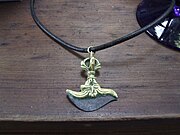
Vajrayāna, also known as Mantrayāna, Guhyamantrayāna, Tantrayāna, Secret Mantra, Tantric Buddhism, and Esoteric Buddhism, is a Buddhist tradition of tantric practice that developed in the medieval Indian subcontinent and spread to Tibet, Nepal, other Himalayan states, East Asia, and Mongolia.

Padmasambhāva, also known as Guru Rinpoche and the Lotus from Oḍḍiyāna, was a tantric Buddhist Vajra master from medieval India who taught Vajrayana in Tibet. According to some early Tibetan sources like the Testament of Ba, he came to Tibet in the 8th century and helped construct Samye Monastery, the first Buddhist monastery in Tibet. However, little is known about the actual historical figure other than his ties to Vajrayana and Indian Buddhism.
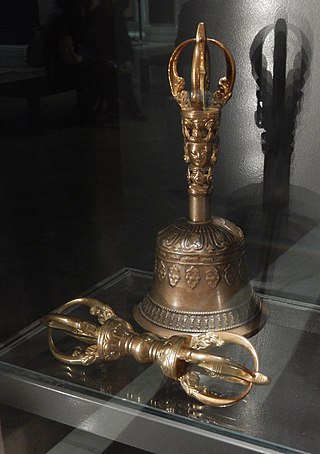
The Vajra is a legendary and ritualistic weapon, symbolizing the properties of a diamond (indestructibility) and a thunderbolt.

Buddhist symbolism is the use of symbols to represent certain aspects of the Buddha's Dharma (teaching). Early Buddhist symbols which remain important today include the Dharma wheel, the Indian lotus, the three jewels and the Bodhi tree.

In Buddhism, wrathful deities or fierce deities are the fierce, wrathful or forceful forms of enlightened Buddhas, Bodhisattvas or Devas ; normally the same figure has other, peaceful, aspects as well. Because of their power to destroy the obstacles to enlightenment, they are also termed krodha-vighnantaka, "Wrathful onlookers on destroying obstacles". Wrathful deities are a notable feature of the iconography of Mahayana and Vajrayana Buddhism, especially in Tibetan art. These types of deities first appeared in India during the late 6th century, with its main source being the Yaksha imagery, and became a central feature of Indian Tantric Buddhism by the late 10th or early 11th century.
A yidam or iṣṭadevatā is a meditational deity that serves as a focus for meditation and spiritual practice, said to be manifestations of Buddhahood or enlightened mind. Yidams are an integral part of Vajrayana, including both Tibetan Buddhism and Shingon, which emphasize the use of esoteric practices and rituals to attain enlightenment more swiftly. The yidam is one of the three roots of the inner refuge formula and is also the key element of deity yoga. Yidam is sometimes translated by the term "tutelary deity".

A ḍākinī is a type of female spirit, goddess, or demon in Hinduism and Buddhism.
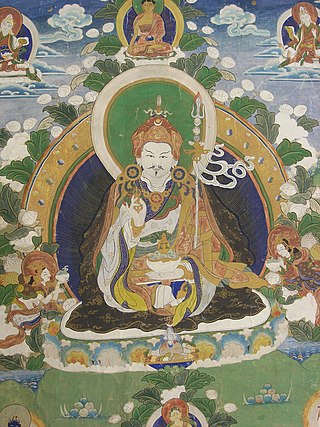
A vajrācārya is a Vajrayana Buddhist master, guru or priest. It is a general term for a tantric master in Vajrayana Buddhist traditions, including Tibetan Buddhism, Shingon, Bhutanese Buddhism, Newar Buddhism.
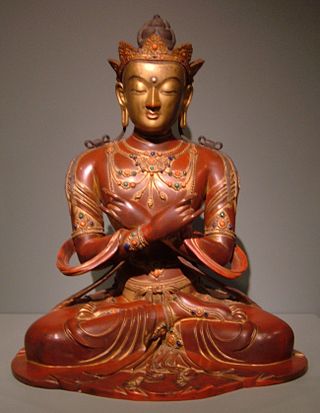
Vajradhara is the ultimate primordial Buddha, or Adi-Buddha, according to the Sakya, Gelug and Kagyu schools of Tibetan Buddhism. It is also a name of Indra, because "Vajra" means diamond, as well as the thunderbolt, or anything hard more generally.
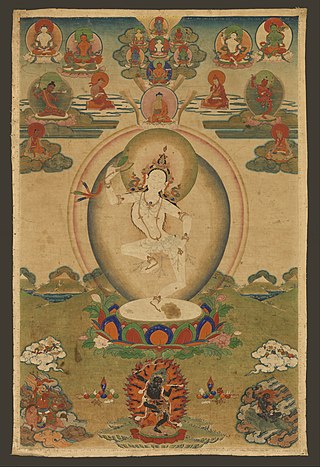
Machig Labdrön, or "Singular Mother Torch from Lab", 1055-1149) was a female Tibetan Buddhist monk believed to be a reincarnation of Yeshe Tsogyal, and the renowned 11th-century Tibetan tantric Buddhist master and yogini that originated several Tibetan lineages of the Vajrayana practice of Chöd.
Chöd is a spiritual practice found primarily in the Yundrung Bön tradition as well as in the Nyingma and Kagyu schools of Tibetan Buddhism. Also known as "cutting through the ego," the practices are based on the Prajñāpāramitā or "Perfection of Wisdom" sutras, which expound the "emptiness" concept of Buddhist philosophy.

Vajrayoginī is a Tantric Buddhist female Buddha and a ḍākiṇī. The Vajrayogini cult dates back to the tenth and twelfth centuries. Vajrayoginī's essence is "great passion" (maharaga), a transcendent passion that is free of selfishness and illusion—she intensely works for the well-being of others and for the destruction of ego clinging. She is seen as being ideally suited for people with strong passions, providing the way to transform those passions into enlightened virtues.

Ekajaṭī or Ekajaṭā, also known as Māhacīnatārā, is one of the 21 Taras. Ekajati is one of the most powerful and fierce protectors of Vajrayana Buddhist mythology. According to Tibetan legends, her right eye was pierced by the tantric master Padmasambhava so that she could much more effectively help him subjugate Tibetan demons.
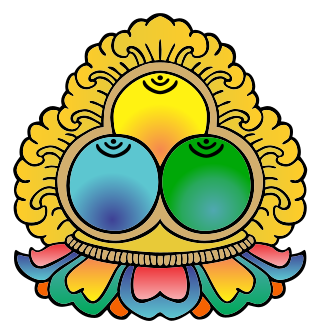
In Tibetan Buddhism, the Three Jewels and Three Roots are supports in which a Buddhist takes refuge by means of a prayer or recitation at the beginning of the day or of a practice session. The Three Jewels are the first and the Three Roots are the second set of three Tibetan Buddhist refuge formulations, the Outer, Inner and Secret forms of the Three Jewels. The 'Outer' form is the 'Triple Gem', (Sanskrit:triratna), the 'Inner' is the Three Roots and the 'Secret' form is the 'Three Bodies' or trikāya of a Buddha.
Nāroḍākinī is a deity in Vajrayana Buddhism similar to Vajrayogini who no longer appears in the active pantheon despite her importance in late Indian Buddhism.
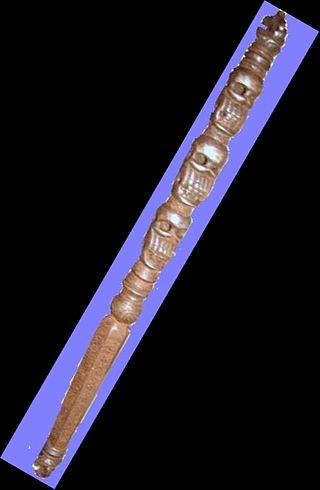
A khaṭvāṅga is a long, studded club originally created as a weapon. It was adopted as a traditional religious symbol in Indian religions such as Tantric traditions like Shaivism and Vajrayana Buddhism. The khatvāṅga was adopted by some lineages of historical tantra though it preceded such traditions as of an original tribal shaman shaft.

A kapala is a skull cup used as a ritual implement (bowl) in both Hindu Tantra and Buddhist Tantra (Vajrayana). Especially in Tibet, they are often carved or elaborately mounted with precious metals and jewels.

The Vidhyeshvari Vajra Yogini Temple - also known as the Bijeśvarī Vajrayoginī, Bidjeshwori Bajra Jogini, Bijayaswar, Bidjeswori, or Visyasvari Temple - is a Newar Buddhist temple in the Kathmandu valley dedicated to the Vajrayāna Buddhist deity Vajrayoginī in her form as Akash Yogini. The temple stands on the west bank of the Bishnumati river next to the ancient religious site of the Ramadoli (Karnadip) cremation ground and is on the main path from Swayambhunath stupa to Kathmandu.

Mekhala "The Elder Severed-Headed Sister" and Kanakhala "The Younger Severed-Headed Sister") are two sisters who figure in the eighty-four mahasiddhas of Vajrayana Buddhism. Both are described as the disciples of another mahasiddha, Kanhapa (Krishnacharya). They are said to have severed their heads and offered them to their guru, and then danced headless. Their legend is closely associated with the Buddhist severed-headed goddess Chinnamunda.

Mundamala, also called kapalamala or rundamala, is a garland of severed human heads and/or skulls, in Hindu iconography and Tibetan Buddhist iconography. In Hinduism, the mundamala is a characteristic of fearsome aspects of the Hindu Divine Mother and the god Shiva; while in Buddhism, it is worn by wrathful deities of Tibetan Buddhism.




